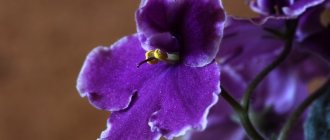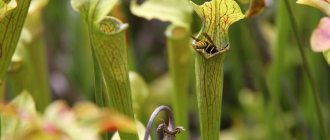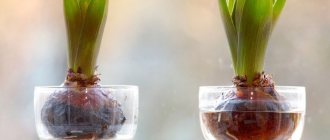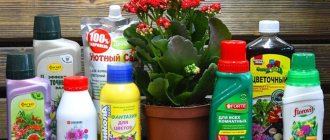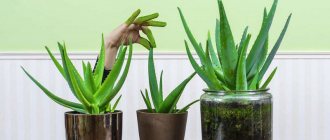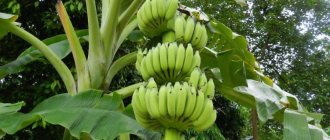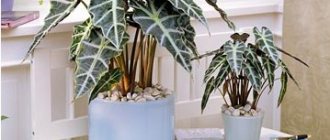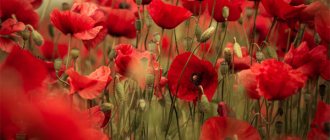Indoor plants can enliven and decorate any interior. Greenery calms us and fills the air with pleasant aromas. But houseplants also have their drawback: they need to be constantly looked after. And it's not just about watering. The soil needs to be loosened and fertilized, ensuring that it is fertile and healthy. If you don't have time to care for your plants, just grow them in water. Hydroponic flowers thrive even without soil. What plants can be grown in water? We'll tell you below.
Dracaena Sandera
Dracaena Sandera is an indoor bamboo that is distinguished by its unpretentiousness. To grow comfortably, it does not require special conditions at all. All you need is not too cold water, from which the dracaena will draw all its nutrients. Bamboo itself looks quite laconic and elegant. Yes, he won’t give you bright flowers. But it has quite large leaves, and the plant itself can grow to impressive sizes.
Interestingly, dracaena is very popular in the East. In Asia, it is placed in rooms to make their interior more harmonious. Bamboo is one of the main plants used in Feng Shui. Place its rhizome in a pot of water. Don't forget to change it from time to time: bamboo doesn't need more. If the plant does not hold well in the pot, add some pebbles or small stones to secure the stems.
“Everything hurts, but it’s bearable”: Pyotr Kuleshov admitted that he was vaccinated against COVID
An effective way to change laws: what the poor people of Ancient Rome did for this
Creating a bright image is real art therapy: sharing ideas
Floating plants of fresh water bodies
Frog watercolor (Hydrocharis morsusranae)
Like all plants in this group, Vodokras does not root in the ground. It moves freely in the water column, simultaneously collecting underwater debris. Small white flowers appear in summer. The leaves resemble a water lily.
Pistia stratiotes
Also known as water lettuce and a plant that effectively cleans the pond. Rosettes of light emerald leaves reach 15 cm in height and 30 cm in width.
For development, the plant needs a warm sunny pond. For wintering it must be moved to a warm aquarium.
Floating pondweed (Potamogeton natans)
This plant has oblong leaves that are brownish-green in color. It grows very quickly and adapts to bodies of water with varying degrees of light. Prefers to live in shallow water.
Lesser duckweed (Lemna minor)
One of the smallest plants from the group of floating ones. Three round leaves form real lawns in the middle of ponds. Duckweed grows profusely only in a body of water that is not cleaned and maintained.
Salvinia natans
This form of fern takes root in sunny and warm bodies of water. The plant is characterized by chiseled, oval-shaped leaves that are clustered on a short floating stem. Their color is green or bronze-green.
Monstera
Monstera is a large plant with massive rugged leaves. It is often placed in heavy pots with fertile soil. Yes, if you want to grow a big monstera, you can't do without soil. But small plants also thrive in water.
It is enough to place the monstera stem in a glass of water, and within a few days it will take root. The plant is generally distinguished by its endurance and unpretentiousness. It can survive in shade, moderate cold and even without soil. It can be placed in bathrooms and kitchens. Simply place the Monstera in a large glass pot and remember to change the water regularly.
Epipremnum aureus
Epipremnum is a perennial plant with small but variegated green leaves. It is known for its unpretentiousness. It can also be grown in soil. The only thing the flower needs is timely watering. Epipremnum comes from the tropics, so it loves humidity. Without moisture, it dries quickly, loses its beauty, and then dies. It loves water so much that it can grow and expand even without soil.
How to avoid mouse hand syndrome: posture and hand training
Sheep on the highway and other photographs for an international photo competition
The terminal of the Novosibirsk airport will be decorated with powerful columns in aviation style
To grow epipremnum, just place the torn stem in water. After a few weeks, the plant will take root and then begin full growth. New leaves will appear, and the stem itself will gradually lengthen. Be prepared to have to trim the roots from time to time. They won't stop growing until you replant them in the ground.
Deep-sea plants of ponds
Water lily (Nymphaea)
The roots of the water lilies reach the bottom soil, and on the surface we admire the leaves and flowers. The latter appear around May and are pleasing to the eye until the onset of autumn.
The advantage of the plant is that it tolerates cold well and overwinters in its natural habitat. Varieties differ in the required depth of the reservoir. It varies from 20 cm for the dwarf variety to 1.5 m for the giant water lily.
Capsule (Nuphar)
This unpretentious plant is suitable for shallow ponds. Planted at a depth of 30 to 60 cm.
Egg pods also require little sunlight. Bright golden-yellow flowers bloom among the beautiful emerald leaves in summer.
Whiteflower shield-leaved (Nympho >
It resembles a small water lily, but in a pond it behaves quite aggressively and quickly fills all available space. Therefore, after planting the white flower at a depth of 40 to 80 cm, its growth is limited.
The round leaves have a wavy edge. The flowers are bright, yellow, with fringed edges.
Ivy
There are many varieties of ivy that you can grow at home. All of them are quite easy to care for. They don't need a lot of light or fertilizer. If you want to grow ivy directly in water, try to choose miniature plants with small leaves. A flower that is too large may not have enough nutrition without soil.
Ivy does not like sudden changes in temperature, so keep it away from drafts. Do not place it next to a radiator or heater. If the plant gets too hot, it will begin to dry out and wilt. If the leaves begin to curl and dry out, spray them additionally to replenish the lack of moisture.
Plectranthus
Plectranthus is one of the most famous hydroponic plants. It requires absolutely no maintenance, so it is often installed in offices and work areas. Plectranthus is especially popular in Asia, where people believe that this plant can bring its owners good luck in all matters related to money. It never blooms, but it will delight its owners with fairly large and bright leaves.
Anaerobic exercises, isometrics: deciphering common fitness terms
The doctor spoke about the expiration dates of antiseptics
Developer: It will be possible to get vaccinated with the CoviVac vaccine again
The plant does not need soil, so it feels good even in water. In it, it begins to actively grow roots. Be prepared to remove them from time to time so they don't fill the entire pot. Plectranthus is best placed on open windows where a lot of light falls. This plant does not tolerate shade and drafts.
aquatic plants
Strictly speaking, only a small group of plants that are constantly in the water column are truly aquatic. Some of them are attached to the bottom by roots (hydrophytes), like elodea (Elodea) or urut (Myriophillum). Others, completely devoid of roots, are in a free-floating state (plestophytes) - hornwort (Ceratophyllum), bladderwort (Utricularia).
Deep-sea plants absorb nutrients to a greater extent through the stems than through the roots, so the stems are branched and their surface is greatly increased. This is clearly observed in the examples of hornwort, uruti, and bladderwort.
In some aquatic plants, a clear dimorphism is observed in the structure of the leaves; underwater and floating ones do not resemble each other in any way. This difference is well expressed in floating pondweed (Potamogeton natans) and, especially, cereal pondweed (Potamogeton gramineus) - their underwater leaves are poorly developed. Needing sunlight, like other flora, many aquatic plants place their main photosynthetic apparatus - leaves - floating on the surface of the water. At the same time, they take root at the bottom and carry the leaves to the surface of the water on long stems, like the water lily (Nimphea) or the egg capsule (Nuphar), or float along with the roots without even touching the ground, like, for example, the frog's water lily (Hydrocharis morsus-ranae) or marsh turkish grass (Butomus umbellatus).
The floating leaves of deep-sea plants have one characteristic feature - the stomata on them are located not on the lower, but on the upper side of the leaf - where they come into contact with air and not with water (water lily, water lily, marsh flower, brazenia). The leaves themselves are thick, leathery, covered with a waxy layer to protect them from excess moisture.
The water lily, or nymphea, is rightfully considered the most luxurious and exquisite plant for a pond. In addition to several natural species, there is a wide variety of varieties that decorate the water surface with their blooms for two months. The most winter-hardy of them come from the quadrangular water lily, found in our nature all the way to the Arctic Circle, and overwinter under thick ice. Heat-loving varieties obtained with the participation of tropical water lilies, often larger and more interesting in the color of flowers and foliage, require a frost-free room for wintering.
Many aquatic plants used to decorate garden ponds are representatives of the Russian flora - marsh flower, bladderwort, pondweed, bagel, salvinia, telores, turcha, wolfia, duckweed - they are well adapted to our harsh climatic conditions.
The organs of aquatic plants located in an airless environment experience a constant deficiency of oxygen and carbon dioxide necessary for life. In this regard, most of them have loose ventilation tissue (aerenchyma), which compensates for the lack of air exchange. It is present in the thickened petioles of water lilies (Nymphea), and in eichornia (Eichornia) and chilim (Trapa) it also acts as a float and promotes their mobility. For the same reason, the stems of many aquatic plants are hollow.
All aquatic plants used today to decorate garden ponds came to us from nature, where they mastered completely different ecological niches - from small puddles and small streams to huge lakes and rivers. Understanding the ecological differences between wet habitats provides keys to successfully growing plants - from planting site selection and soil conditions to management principles.
Artificially created garden ponds, as a rule, have a controlled inflow and outflow of water. In nature, standing and flowing reservoirs create different conditions for plants. Plants with long stems are not found in large lakes due to the great depth, but grow in small ponds, regardless of depth.
Large leaves are found on plants that live in stagnant or slow-flowing waters, for example, yellow egg capsule (Nuphar lutea), amphibian knotweed (Polygonum amphibium). In flowing bodies of water (rivers, streams, springs), plants must withstand mechanical loads created by the flow, so they usually have medium-sized foliage. Some plants that prefer cold spring water do not take root well in heated garden ponds. And underwater plants of streams and springs, where water near the surface has constant contact with air, do not tolerate the oxygen-poor water of stagnant bodies of water.
The most reliable assortment of aquatic plants for temperate climates is the local natural flora. Among them are the quadrangular water lily (Nymphaea tetragona), the marsh flower (Nymphoides peltata), the amphibian knotweed (Polygonum amphibium), the floating water lily (Trapa natans), the aloe vera (Stratiotes aloides), and the floating salvinia (Salvinia natans). They alone may be enough to decorate a pond.
However, more heat-loving plants can also diversify the flora of a garden pond. When acquiring non-winter-hardy species, you need to think about wintering them. Heat-loving hybrid water lilies are placed in a cool basement, covered with sphagnum moss.
Plants such as Salvinia auriculata, Azolla caroliniana, Pistia stratiotes, and Eichhornia crassipes can overwinter in an aquarium.
It is worth mentioning separately about mini-reservoirs arranged in containers. It is in them that some exotic plants living in aquariums are most often used.
For all those who cannot afford the luxury of having a garden pond, even a miniature pond with 3-5 species of plants will bring a lot of joy and become an interesting garden object.
Photo: Maxim Minin, Rita Brilliantova
Sweet potato
Of course, you shouldn't expect to be able to harvest a full crop of sweet potatoes if you grow them in water. But the plant can grow, decorating the room with curly branches with large leaves. In appearance, the sweet potato resembles ivy.
To plant this plant, place the sweet potato fruit in a bowl of water. Leave it there for a few weeks until it takes root. After this, it can be transplanted into a pot with soil or left in water. The sweet potato will begin to slowly but surely stretch in length, growing more and more new stems. Don’t forget to change the water promptly and cut off dried branches.
Main representatives
Cyperus
Cyperus
This is the most famous and unpretentious of indoor aquatic plants. Its triangular, strong stems, growing in a bunch, end in a lush “fountain” of leaves spreading to the sides. For such a characteristic appearance, Cyperus is often called “palm tree”. In fact, he belongs to the Osokov family. Its homeland is the wetlands of tropical Africa. Its closest relative is papyrus. And our pet is often called by a double name: Cyperus-Papyrus. This plant can be grown simply in a container of water. There is never too much water for him. The more it is, the more magnificent it grows. It is usually grown in flowerpots that stand in deep trays that are constantly filled with water.
Calla
Calla, or calla lily
The second most popular indoor plant, preferring to grow almost submerged in water. This marsh plant came to us from the subtropical regions of South America. Its charming snow-white blanket surrounding the bright yellow ear of the upward-pointing inflorescence looks solemn and elegant. Pots with calla lilies, like cyperus, feel best when placed in trays filled with water. The popularity of the flower is associated not only with its magical beauty, but also with the significant plasticity of the plant. Calla lilies can also grow in conditions of relative lack of moisture. True, in this case you can’t count on lush flowering.
Eichornia
Eichornia
It is also called water hyacinth. She is also surprisingly unpretentious. The main condition for it is water. In nature, Eichornia grows in the tropical part of South America. However, thanks to its vitality, it now grows successfully in many warm climates around the world, earning it the nickname “water plague.” Eichornia is often used by aquarists, growing it on the surface of the water. It also enjoys well-deserved attention from flower growers. This indoor aquatic plant prefers to grow in wide, but not small, containers of water, which are placed in a warm place with sufficient lighting. Drafts are extremely undesirable. In the summer, when conditions are most favorable for it, Eichornia will delight you with graceful lilac flowers, indeed, reminiscent of hyacinths.
Drooping reed
Drooping reed
This plant is not distinguished by lush flowering, but its delicate thin thread-like leaves give it a peculiar charm. It is no coincidence that flower growers, touched by its airy appearance, gave it a number of affectionate names: “cuckoo tears”, “graceful isolepis”, “hair grass”. The young leaves of this reed first grow vertically. Gradually, becoming longer, they begin to bend, forming a lush bunch of thin green tubes with silvery lights of small rounded inflorescences at the tips. This allowed flower growers to humorously call this reed “fiber-optic grass.” It is for this reason that the flower looks most impressive in tall flowerpots standing in filled trays.
Bamboo
Bamboo
Many varieties of bamboo, especially low-growing varieties, are excellent for growing in water. But it does relatively well with less moisture. Maybe he can put up with some lack of light. Bamboo is very plastic both in terms of growing conditions and the ability to give it different shapes. It grows quickly, creating fancy bushes. There are a lot of varieties of bamboo; you can choose both low-growing and powerful plants.
Calamus cereal
Calamus cereal
This species is completely undemanding to growing conditions. The only thing he needs in large quantities is water. The modest appearance of the plant is not a reason to refuse to grow it in our homes. It perfectly complements compositions with calla lilies or bamboo. It is good to use for decorating a loggia or veranda. And in the summer, pots with calamus can be placed in a decorative pond at the dacha or in the garden. In any place, this plant will delight not only with its bright greenery, but also with a pleasant aroma reminiscent of tangerine.
Pontederia in composition
Pontederia
This is a very showy plant with shiny leaves and flowers in lilac, blue or white. Its homeland is South, Central and North America, from tropical to warm temperate parts. The flower grows in shallow areas of rivers and lakes. Therefore, when cultivating pontederia, it must be planted in water to a depth of about 8 cm. The height of its bushes reaches half a meter. In summer, purple spike-shaped inflorescences appear among the bright heart-shaped leaves. Flowering continues all summer until almost half of autumn. Then the pontederia begins a period of rest, but its luxurious bushes do not lose their attractiveness.
Based on these moisture-loving plants, you can create various compositions that will decorate your home, make it cozier and more comfortable. There is no need to try to buy all of them; just choose three or four types you like. They will delight you all year round. Just don't forget to add water.
Aglaonema
Aglaonema is a small plant, notable for its massive yellow-green leaves with red veins. It does not tend to grow, so it does not have to be trimmed and trimmed. Aglaonema grows well both in soil and in water, but it will be an excellent addition to even a minimalist interior. Its roots also do not grow, so the flower can be placed in small pots. Just remember to change the water promptly so that the plant does not lack nutrition.
A coronavirus mutation “invisible” to PCR tests has been identified in France
Dangerous not only for humans, but also for the Earth: how to protect yourself from magnetic storms
Parents' Saturday (March 27): a big mistake of almost all believers on this day
How to grow plants on water. What plants can be grown hydroponically?
Best of all, greens grow hydroponically.
This includes: parsley, dill, basil, sage, rosemary, cilantro, mint, lemon balm, lettuce, etc. It is also not difficult to grow indoor plants using this method, such as: aglaonema, asparagus, aspelenium, cissus, dieffenbachia, howea, philodendron, phalangium, ivy, ficus, fatsia, common ivy, hoya and many others.
Vegetable crops, berries and even some fruits are in no way inferior: broccoli, green beans, eggplant, spinach, cucumbers, tomatoes, strawberries, strawberries, many varieties of legumes, kohlrabi, banana, bell peppers, onions and much more, will also delight you with an excellent harvest grown hydroponically.
All these plants are perfect for growing hydroponically, both on an industrial scale and at home.
But there are also plants that are simply not recommended to be grown hydroponically. And this is not because they will not grow, but due to their structural features.
For example, it is not recommended to grow plants hydroponically:
- forming tubers or rhizomes. If this type of plant is not watered correctly, the root system will begin to rot. Such plants include potatoes, beets, carrots, cyclamen, etc.;
- mushrooms; having rapidly growing roots (cyperus, chlorophytum);
- short-lived (exakum); requiring frequent cleaning. Cleaning is necessary to remove any remaining leaves and flowers;
- did not clog the hydroponic system (tall begonia, balsam); For flowering, cool temperatures during the dormant period are required (hydrangea, clivia and liazalia). This type of plant reacts to changes in temperature by rotting its roots.
It should be noted that each individual solution for hydroponics corresponds to a specific group of plants.
Syngonium
Syngonium is another unpretentious plant that is widely used to decorate offices and work spaces. It will easily fit into any design, but will not require special care. Syngonium has bright and shiny green leaves, which also exude a pleasant herbaceous aroma.
The plant can be placed in a small pot of water and left there for several months. Syngonium grows equally well both in the sun and in the shade. It is also quite resistant to temperature changes, so it can even be placed on window sills with light drafts.
Aquatic plants: photo, description, use
Aquatic plants are special species that have adapted to exist in various bodies of water and serve not only as decoration, but also bring benefits to them. On the one hand, a layer of leaves above the water surface in summer protects from the heat. On the other hand, plants in reservoirs often become a source of food for their inhabitants. This is why hydrophytes are so important not only from an aesthetic, but also from a practical point of view.
What aquatic plants to choose for a pond? To answer this question, first of all, it should be noted that all types of plants, examples of which are given below, are divided into three groups: deep-water, floating and shallow-water. In reservoirs, all three varieties are usually combined so that the total amount does not exceed 1/5 of the water surface. Choose from the following flora representatives:
Tradescantia
Tradescantia has many varieties, and they are all distinguished by their unpretentiousness. It is usually grown in miniature pots, since the flowers do not tend to grow. Tradescantia is known for its dark green leaves with a bluish undertone. They are attractive because they are cut with bright white and purple stripes.
Any variety of Tradescantia can be grown directly in water. Cut any large stem from the plant and place it in the liquid. In a week or two it will take root. After this, you can transplant the flower into a pot, or you can leave it directly in the water. It needs to be changed when it starts to darken and oxidize. Tradescantia does not require any other special care.
How to make an indoor pond
Before you make an indoor pond, you need to prepare a container: you can use any container that can hold at least 25 liters of water. It must be decorative, waterproof, non-corrosive and non-toxic. The indoor pond should also be deep enough so that there is at least 15 cm of water above the top of the basket with plants. An 80-liter one is best. Coat the outside with varnish and treat the inside with a sealant, such as bitumen paint. Place the container in the most well-lit area.
Run tap water and wait at least three days before planting. You will need a dwarf pitcher plant and some floating plants, as well as oxygenators to help suppress algae growth. The surface of the water should be covered with leaves. Subsequently, when the water lily leaves begin to grow, some floating plants are removed.
Spathiphyllum
Spathiphyllum is an indoor flower, distinguished by its elongated leaves and massive white buds. It is often grown in soil, but the plant will actually be much more comfortable in water. Hydroponics is the ideal way to propagate spathiphyllum. In order for the plant to bloom profusely, nutrient mixtures will have to be added to the water. But even without them, spathiphyllum grows quite well.
